|
||||||
|
ELYMUS. Couches. [Poaceae] |
|
Two species and one variety of Elymus are recorded in Britain. These include the native Bearded Couch (E. caninus). The BSBI provide a downloadable plant crib for Elymus. Twenty-one British miners are recorded on Elymus. A key to the European miners recorded on Elymus, is provided in Bladmineerders van Europa. Nearly 100 British miners or possible miners are recorded on grasses in Britain. It is recommended that adults of all miners on grasses be reared to be certain of their identity. |
Key for the identification of the known mines of British |
1# > ? Leaf-miner: Details of mine unknown. Puparium shining brown |
|
Cerodontha calosoma (Hendel, 1931) [Diptera: Agromyzidae]. |
1a > Leaf-miner: The young larva first feeds towards the apex of the leaf, later turning and feeding downwards. Several larvae can occur together in a single leaf. Pupation external (Spencer, 1976: 130). Upper-surface, greenish, gradually widening corridor, at first running towards the leaf tip, then reverses. Through fusion of several mines the final mine is often communal. Frass in backish green grains, often washed out. Pupation outside the mine. Puparium reddish brown |
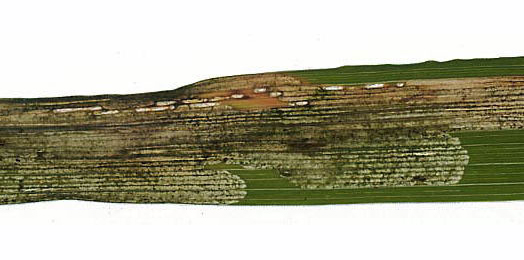 Mine of Agromyza nigrociliata on Arrhenatherum elatius Image: © Willem Ellis (Bladmineerders van Europa) |
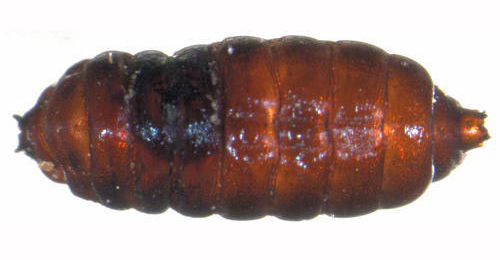 Agromyza nigrociliata puparium Image: © Willem Ellis (Bladmineerders van Europa) |
|
Agromyza nigrociliata Hendel, 1931 [Diptera: Agromyzidae]. |
1b > Leaf-miner: Long upper-surface corridor usually containing several larvae that graze shoulder to shoulder from the leaf tip downwards. Pupation outside the mine. Mines and larvae are indistinguishable from those of A. nigrella. |
|
Agromyza mobilis Meigen, 1830 [Diptera: Agromyzidae]. |
1c > Leaf-miner: Larva feeds mainly in the leaf sheaths. The short mines which may be formed in the leaf blade may be easily overlooked. Pupation internal (Spencer, 1976: 178). Mine begins as a narrow, usually upper-surface, occasionally lower-surface or interparenchymatous corridor in the blade, that descends towards the ligule, thence continues into the leaf sheath, generally on its inside. Usually only one mine per leaf. Puparium in a puparial chamber at the margin of the leaf sheath. Neither mine nor larva can be distinguished from that of C. fulvipes that, as far as is known, only feeds on Poa trivialis. |
|
Cerodontha denticornis (Panzer, 1806) [Diptera: Agromyzidae]. |
1d > Leaf-miner: A lower surface mine. Pupation normally in the ground (Spencer, 1976: 202). Broad, usually lower-surface corridor in the blade, generally first rising, then descending. Mostly one larva in a mine, but sometimes several mines on a leaf may merge. Frass in grains that gradually become both larger and more widely spaced. Pupation outside the mine. |
|
Cerodontha flavocingulata (Strobl, 1909) [Diptera: Agromyzidae]. |
1e > Leaf-miner: Broad lower surface mine which generally starts at the leaf apex.The mine is somewhat irregular in depth. Frass in irregular black-green, frequently melted grains, mostly along the edges of the mine. Larva solitary. Pupation generally internal. |
|
Cerodontha muscina (Meigen, 1830) [Diptera: Agromyzidae]. |
1f > Leaf-miner: Upper-surface corridor, generally in the upper half of the blade, running up to the leaf tip, usually occupying more then half the width of the leaf. Frass in green stripes at either side of the corridor. Never more than one larva in a mine. Puparium within the mine, metallic black, not anchered with a string of silk. |
|
Cerodontha superciliosa (Zetterstedt, 1860) [Diptera: Agromyzidae]. |
1g > Leaf-miner: A linear mine running towards the apex of the leaf and this can widen and become almost blotch-like. Pupation internal (Spencer, 1976: 194, 195 (fig. 340). Upper surface corridor, mostly in the lower half of the blade, running upwards, and never occuping more than half the width of the leaf. Larva solitary. Frass in green smears. Pupation inside the mine. |
|
Cerodontha lateralis (Macquart, 1835) [Diptera: Agromyzidae]. |
1h > Leaf-miner: Normally several larvae feed together. Pupation in the mine. Puparium shining black (Spencer, 1976: 198). Broad elongated blotch. Frass greenish. Larvae generally communal. Pupation within the mine. The black puaria are individially anchored within the mine with a silken thread attached at their rear end. Distinguishable from C. incisa only by means of the larva. |
|
Cerodontha pygmaea (Meigen, 1830) [Diptera: Agromyzidae]. |
1i > Leaf-miner: Broad elongated mine; the form is dependent of the leaf form of the host plant. Frass green. Usually a number of larvae together in a mine. Pupation in the mine. |
|
Cerodontha incisa (Meigen, 1830) [Diptera: Agromyzidae]. |
1j > Leaf-miner: Long, narrow, whitish mine. Pupation internal (Spencer, 1976: 453); anterior spiracles projecting through the epidermis. Whitish, upper-surface, rather narrow corridor with comparatively large frass grains that are laying further apart than their diameter. Pupation within the mine. The anterior spiracles of the orange-brown puparium penetrate the epidermis. |
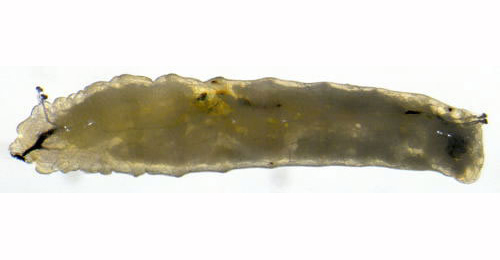 Chromatomyia nigra larva, lateral Image: © Willem Ellis (Bladmineerders van Europa) |
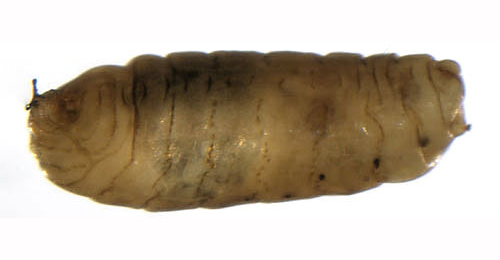 Chromatomyia nigra pupa, lateral Image: © Willem Ellis (Bladmineerders van Europa) |
|
Chromatomyia nigra (Meigen, 1830) [Diptera: Agromyzidae]. |
1k > Leaf-miner: A narrow whitish linear mine, running down the leaf from the apex, with frass in two rows of separate grains. Pupation external (Spencer, 1976: 246). Narrow corridor from start to end, whitish, uppper- or lower-surface, genarally running downwards. Mine often along the leaf margin. Frass in distict grains of regular size, alternating along the sides of the corridor. Pupation outside the mine. |
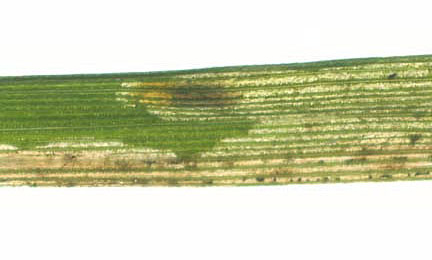 Mine of Liriomyza flaveola on Festuca gigantea Image: © Willis Ellis (Bladmineerders van Europa) |
|
Liriomyza flaveola (Fallén, 1823) [Diptera: Agromyzidae]. |
1l > Leaf-miner: A short narrow mine, generally near apex of leaf. Larva with each segment bearing a row of characteristic papilli which are retained in the puparium (Spencer, 1976: 328). Pupation internal. Transparent, short and narrow mine not far from the leaf tip. Frass in two rows of grains. Pupation outside the mine. |
|
Pseudonapomyza atra (Meigen, 1830) [Diptera: Agromyzidae]. |
Key for the identification of the known mines of British |
|
Note: The larvae of mining Coleoptera, Hymenoptera and Lepidoptera may live in a corridor mine, a corridor-blotch mine, a blotch mine, a case, a rolled or folded leaf, a tentiform mine or sandwiched between two more or less circular leaf sections in later instars. Larva may pupate in a silk cocoon. The larva may have six legs (although they may be reduced or absent), a head capsule and chewing mouthparts with opposable mandibles (see video of a gracillarid larva feeding). Larvae of Hymenoptera and Lepidoptera usually also have abdominal legs (see examples). Frass, if present, never in two rows. Unless feeding externally from within a case the larva usually vacates the mine by chewing an exit hole. Pupa with visible head appendages, wings and legs which lie in sheaths (see examples). |
|
1a > Seed-feeder, leaf-miner and case-bearer: Initially it feeds on the seeds of thyme and then uses the seedhead as a case. It overwinters in this case and starts feeding again in March on grass spp. It then makes a case from the mined blade of grass. The larva initially feeds on the seeds of thyme, feeding within a floret and using this as its case. After overwintering, it changes foodplants to grass, and eventually forms an elongated case from two grass blade portions sewn together. The larva begins its life by eating out the ripe fruit of a thyme floret. The emptied and dried calyx functions as its first case, in which it hibernates. After hibernation the larva switches to grasses, initially in its original thyme case. Later a new case is made out of a mined grass leaf. This final case is about 11 mm long, two-valved, straw-coloured, has a mouth angle of 25°, and bears a striking resemblance to a grass spikelet. |
|
|
|
Coleophora lixella Zeller, 1849 [Lepidoptera: Coleophoridae] |
|
1# > Leaf-miner: Details unknown. |
|
|
|
Elachista littoricola Le Marchand, 1938 [Lepidoptera: Elachistidae] |
|
1a > Leaf-miner: Tufted hair-grass and blue moor-grass are the main foodplants, the larvae forming gallery mines. Gradually widening corridor, running either upwards or down. All frass is deposited in the earliest part of the mine. Often 2-3 larvae in a mine; in grasses with broad leaves sometimes more than one mine in a leaf. |
|
|
|
Elachista adscitella Stainton, 1851 [Lepidoptera: Elachistidae]. |
|
1b > Leaf-miner: The larva mines from the grass tip downwards and the mine occupies half or the whole of the leaf blade width. A whitish blotch is formed with characteristic narrow streaks of frass. Full depth blotch, slightly inflated, descending from the leaf tip, occupying half or the entire width of the blade. The larva may move and make a new mine elsewhere. In the latter case the mines are fairly short; otherwise an entire blade may be mined out. Frass in a some narrow greyish brown streaks. Pupation outside the mine. |
|
|
|
Elachista albifrontella (Hübner, 1817) [Lepidoptera: Elachistidae]. |
|
1c > Leaf-miner: Corridor widening while descending from the tip of the leaf. The mine is unusual because the sides are very irregularly scalloped out. Moreover, the mine is not evenly transparent, but rather yellowish green and motly, because the larva leaves patches of parenchyma uneaten, and does not feed full depth. Frass in a few irregular, interrupted length lines. Often 2-3 larvae in a mine. The larvae hibernate in the centre of the mine; after winter they leave their mine and pupate. |
|
|
|
| Elachista apicipunctella Stainton, 1849 [Lepidoptera: Elachistidae]. | |
1d > Leaf-miner: A small narrow mine on a wide variety of grasses. In the spring the larva changes leaves and mines tip downwards. The mine fills the leaf width. The frass is packed in the top of the mine. In autumn the larva makes a narrow corridor a few cm in length, in which it hibernates. In March it moves to a new leaf. Here a transparent, full depth mine is made that descends from the leaf tip, and occupies the entire width of the blade. Most frass is concentrated in the oldest, highest, part of the mine. The larva may leave its mine and restart elsewhere. Pupation outside the mine (Bladmineerders van Europa) |
|
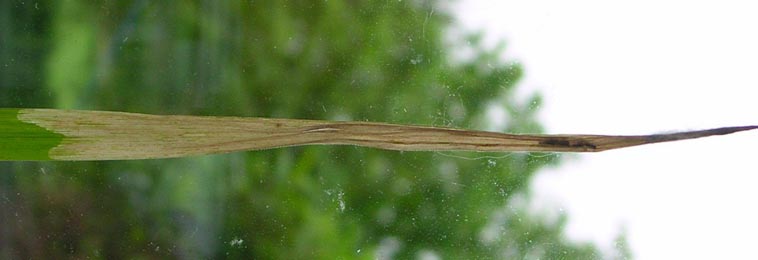 Mine of Elachista argentella on Dactylis glomerata Image: © Ben Smart (British leafminers) |
|
|
|
Elachista argentella (Clerck, 1759) [Lepidoptera: Elachistidae]. |
|
1e > Leaf-miner: Larva makes a large whitish blotch and mines the leaf downwards. The frass tends to be deposited in the upper part of the mine. Oviposition usually not far from the leaf tip. From there descends an irregular blotch mine. Hering (1957a) describes the mine as flat and quite shallow, giving it a greenish, rather than whitish appearance. Frass initially in the oldest, upper part of the mine, later in strings. The larva can leave its mine and restart elsewhere. Normally only one larva per mine, but sometimes two or even three mines in a leaf. Pupation outside the mine. |
|
|
|
Elachista maculicerusella (Bruand, 1859) [Lepidoptera: Elachistidae]. |
| Last updated 04-Jul-2019 Brian Pitkin | ||
